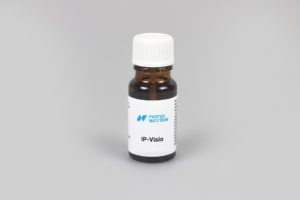 At one of the world’s leading photonics, laser, and biomedical optics conference taking place right now in San Fransisco, California, the SPIE BiOS and Photonics West conference, German-based two-photon polymerization technology company Nanoscribe has announced the release of its latest new printing material that can turn innovations on the microscale into biocompatible products. Known as IP-Visio, the development was designed to print filigree and low-fluorescent 3D microarchitectures for tissue engineering.
At one of the world’s leading photonics, laser, and biomedical optics conference taking place right now in San Fransisco, California, the SPIE BiOS and Photonics West conference, German-based two-photon polymerization technology company Nanoscribe has announced the release of its latest new printing material that can turn innovations on the microscale into biocompatible products. Known as IP-Visio, the development was designed to print filigree and low-fluorescent 3D microarchitectures for tissue engineering.
A spin-off of the Karlsruhe Institute of Technology (KIT), Nanoscribe develops and provides 3D printers for the nano, micro, and mesoscale, along with photoresists and process solutions. Rallying up the slogan: “We make small things matter,” company founders managed to develop a technology that can 3D print products crucial for smartphones, handheld devices and in the field of medical technology. Making two-photon polymerization (2PP) based 3D printers commercially available they have already offered solutions to universities and pioneering industries worldwide, working on 3D microprinting life sciences studies, as well as 3D printing optics at the nanoscale, and even using their technology to develop innovative devices like the 3D-microscaffold cochlear implant for steroid elution.

Biocompatible 3D microstructure fabricated with Nanoscribe’s printing technology (Credit: Nanoscribe)
According to Nanoscribe, 2D cell culture systems have been standard for the past century, enabling findings in many applications, ranging from stem cell research, drug screening, and regenerative medicine. However, cells interact with neighboring cells, the extracellular matrix, and surrounding molecules in 3D. Cells in vivo experience an extremely complex three-dimensional environment at the organ, tissue and cellular level down and below the micrometer scale. Nanoscribe’s 3D microfabrication has demonstrated how this technology enables the fabrication of intricate 3D microstructures such as 3D cell scaffolds. With IP-Visio, the company takes a step further in the fabrication of biocompatible 3D microstructures.
The new Nanoscribe printing material is non-cytotoxic according to ISO10993-5, the biological evaluation of medical devices that test for in vitro cytotoxicity. This makes IP-Visio suitable for cell-friendly 3D scaffolds. The company claims that with this material, high-precision microstructures can be fabricated to mimic realistic and high-precision microenvironments.
Moreover, IP-Visio shows very low autofluorescence, which as stated by Nanoscribe, means this property allows a clear view through the printed scaffolds, whereby scientists can analyze cellular components and processes by means of fluorescence microscopy without the interference of the printed structures.
After 10 years of being on the market, Nanoscribe has helped customers become pioneers and innovation leaders in science and industry, for example, producing DOEs, micro-optics as well as photonic wire bonds for ICT. And with more than 1,000 users in 30 countries, their new IP-Visio is sure to draw a lot of attention.
At both the SPIE BiOS booth number 8256 and Photonics West booth 3254 at hall E, Nanoscribe will present their new product that enables microfabrication in biocompatible quality, as well as numerous exhibits of their 3D microfabrication technology and what it can be used for: from high precision 3D microparts to millimeter-scale mechanical components and biocompatible structures for life science applications. Moreover, they will demonstrate innovative application samples of optical quality made possible by the new maskless lithography system Nanoscribe Quantum X, including microlens arrays and diffractive optical elements.
Join the discussion of this and other 3D printing topics at 3DPrintBoard.com.
Subscribe to Our Email Newsletter
Stay up-to-date on all the latest news from the 3D printing industry and receive information and offers from third party vendors.
You May Also Like
Printing Money Episode 17: Recent 3D Printing Deals, with Alex Kingsbury
Printing Money is back with Episode 17! Our host, NewCap Partners‘ Danny Piper, is joined by Alex Kingsbury for this episode, so you can prepare yourself for smart coverage laced...
Insights from Cantor Fitzgerald on AM’s Q1 2024 Landscape
A recent survey by Cantor Fitzgerald sheds light on the persistent challenges within the additive manufacturing (AM) industry in the first quarter of 2024. Based on responses from 38 industry...
3D Printing Financials: Xometry’s Scaling up and Strong Start to 2024
Xometry (Nasdaq: XMTR) kicked off 2024 with strong results, boosting its marketplace and technology to new heights. Both revenue and gross margin soared, fueled by an expanding global network of...
3D Printing Financials: Desktop Metal Targets Recovery Amid Net Losses and Revenue Downturn
Despite facing a decline in revenue and the persistent challenges of a tight economic climate, Desktop Metal (NYSE: DM) is making strides toward operational efficiency. The first quarter of 2024...

































